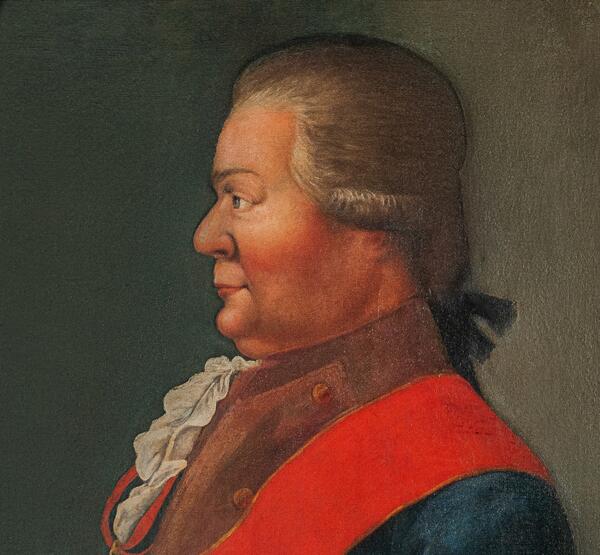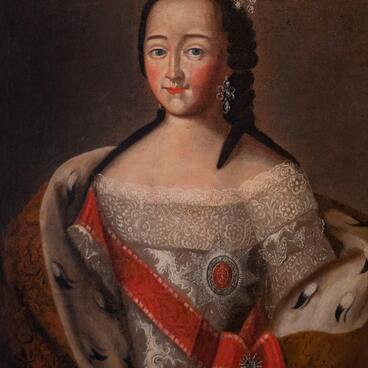This portrait entered the museum’s collection “The Old Mansion” from the Arkhangelsk Museum of Local Lore. It was originally registered as “Portrait of an Official of the 18th century” and was not associated with any specific historical figure. The person depicted in the portrait wears the 1st Class Order of St. Anna (a red ribbon over a left shoulder was provided only for the first class of the order), and the eight-pointed Vladimir star corresponds to the 1st or 2nd Class of the Order of St. Vladimir.
According to the research conducted by the employees of the Museum Association “Art Culture of the Russian North”, the painting depicts the Arkhangelsk Governor-General Pyotr Konovnitsyn. The portrayed person was identified thanks to an exhibition of works by Dmitry Levitsky, held in 1985 at the State Russian Museum. It displayed portraits of the Order of St. Vladimir Knights that were commissioned by Empress Catherine II herself, who established this award in 1782.
Among these portraits was the image of a person related to Arkhangelsk — Governor-General Pyotr Konovnitsyn. Levitsky’s painting depicts Konovnitsyn with the 1st Class Orders of St. Anne and the 2nd Class Order of St. Vladimir. The information given in the exhibition catalog confirmed that the person depicted was the governor-general of the Arkhangelsk and Olonets governorates. When this portrait was compared with the ‘Portrait of an Official of the 18th century’, researchers were convinced that both paintings portrayed the same person: with a puffy face, a double chin, a large nose bent down, and wearing the same orders.
There is little information known about his life. Before being the governor of Petrozavodsk, he was the governor of St. Petersburg. The Konovnitsyn family is very old and has the same origin as the Romanovs. Pyotr Konovnitsyn’s son, also named Pyotr was a hero of the Patriotic War of 1812, a participant in the Battle of Borodino and Kutuzov’s right-hand man. Konovnitsyn’s granddaughter, Elizaveta Petrovna, was the wife of the Decembrist Mikhail Naryshkin, whom she followed to Siberia.
Levitsky’s portrait of Konovnitsyn and the Arkhangelsk portrait were painted five years apart. The artists were of different degrees of talent. Levitsky depicted Konovnitsyn in St. Petersburg when he was the governor: everything about him radiates a quiet confidence of a dignified and reputable tsarist official.
The artistic value of the Arkhangelsk portrait is significantly inferior to that of Levitsky’s portrait. The official is depicted in profile, his flabby cheeks and a double chin stand out more clearly, and his facial features — a large nose, a chin and thin lips — are sharply outlined. During the restoration process, it was discovered that the color of the uniform was blue. In 1784, Catherine II issued a decree on the assignment of special colors and dresses to each viceroyalty. Arkhangelsk officials were supposed to wear a blue uniform with a crimson collar and lapels, which is exactly what Konovnitsyn wears in the portrait.
According to the research conducted by the employees of the Museum Association “Art Culture of the Russian North”, the painting depicts the Arkhangelsk Governor-General Pyotr Konovnitsyn. The portrayed person was identified thanks to an exhibition of works by Dmitry Levitsky, held in 1985 at the State Russian Museum. It displayed portraits of the Order of St. Vladimir Knights that were commissioned by Empress Catherine II herself, who established this award in 1782.
Among these portraits was the image of a person related to Arkhangelsk — Governor-General Pyotr Konovnitsyn. Levitsky’s painting depicts Konovnitsyn with the 1st Class Orders of St. Anne and the 2nd Class Order of St. Vladimir. The information given in the exhibition catalog confirmed that the person depicted was the governor-general of the Arkhangelsk and Olonets governorates. When this portrait was compared with the ‘Portrait of an Official of the 18th century’, researchers were convinced that both paintings portrayed the same person: with a puffy face, a double chin, a large nose bent down, and wearing the same orders.
There is little information known about his life. Before being the governor of Petrozavodsk, he was the governor of St. Petersburg. The Konovnitsyn family is very old and has the same origin as the Romanovs. Pyotr Konovnitsyn’s son, also named Pyotr was a hero of the Patriotic War of 1812, a participant in the Battle of Borodino and Kutuzov’s right-hand man. Konovnitsyn’s granddaughter, Elizaveta Petrovna, was the wife of the Decembrist Mikhail Naryshkin, whom she followed to Siberia.
Levitsky’s portrait of Konovnitsyn and the Arkhangelsk portrait were painted five years apart. The artists were of different degrees of talent. Levitsky depicted Konovnitsyn in St. Petersburg when he was the governor: everything about him radiates a quiet confidence of a dignified and reputable tsarist official.
The artistic value of the Arkhangelsk portrait is significantly inferior to that of Levitsky’s portrait. The official is depicted in profile, his flabby cheeks and a double chin stand out more clearly, and his facial features — a large nose, a chin and thin lips — are sharply outlined. During the restoration process, it was discovered that the color of the uniform was blue. In 1784, Catherine II issued a decree on the assignment of special colors and dresses to each viceroyalty. Arkhangelsk officials were supposed to wear a blue uniform with a crimson collar and lapels, which is exactly what Konovnitsyn wears in the portrait.



